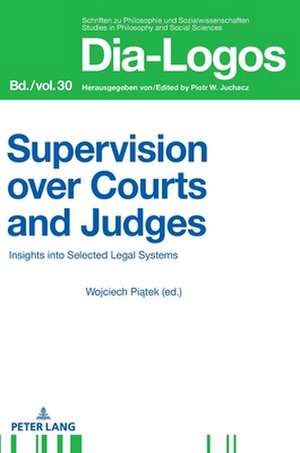Supervision over Court and Judges: Dia-Logos
en Limba Engleză Hardback – 28 oct 2021
Din seria Dia-Logos
-
 Preț: 368.60 lei
Preț: 368.60 lei -
 Preț: 517.53 lei
Preț: 517.53 lei - 23%
 Preț: 451.25 lei
Preț: 451.25 lei - 23%
 Preț: 456.40 lei
Preț: 456.40 lei -
 Preț: 422.63 lei
Preț: 422.63 lei -
 Preț: 464.05 lei
Preț: 464.05 lei -
 Preț: 463.08 lei
Preț: 463.08 lei - 8%
 Preț: 541.14 lei
Preț: 541.14 lei - 23%
 Preț: 484.10 lei
Preț: 484.10 lei - 23%
 Preț: 600.67 lei
Preț: 600.67 lei - 23%
 Preț: 516.59 lei
Preț: 516.59 lei - 23%
 Preț: 570.57 lei
Preț: 570.57 lei - 23%
 Preț: 467.47 lei
Preț: 467.47 lei - 23%
 Preț: 553.67 lei
Preț: 553.67 lei - 23%
 Preț: 463.33 lei
Preț: 463.33 lei - 20%
 Preț: 459.14 lei
Preț: 459.14 lei - 20%
 Preț: 466.88 lei
Preț: 466.88 lei
Preț: 456.48 lei
Nou
Puncte Express: 685
Preț estimativ în valută:
87.37€ • 94.94$ • 73.44£
87.37€ • 94.94$ • 73.44£
Carte tipărită la comandă
Livrare economică 21 aprilie-05 mai
Preluare comenzi: 021 569.72.76
Specificații
ISBN-13: 9783631836170
ISBN-10: 3631836171
Pagini: 228
Dimensiuni: 148 x 210 mm
Greutate: 0.44 kg
Editura: Peter Lang Copyright AG
Seria Dia-Logos
ISBN-10: 3631836171
Pagini: 228
Dimensiuni: 148 x 210 mm
Greutate: 0.44 kg
Editura: Peter Lang Copyright AG
Seria Dia-Logos
Notă biografică
Wojciech Piatek is Professor in the Institute of Administrative and Judicial Administrative Procedure at the Adam Mickiewicz University in Poznan and a specialist in the Jurisprudence Office of the Supreme Administrative Court in Warsaw. His research focuses on the international and constitutional framework for the functioning of the judiciary, administrative proceedings and comparative public law.
Cuprins
Definition of supervision - judicial independence - court organization from the perspective of the European Convention - scope of the supervision - entities responsible for exercising it - measures of supervision - adoption of new technologies - trust placed in the courts.
Descriere
The book discusses such issues as: the definition of supervision over courts and judges; the differences between its various components; the scope of the supervision; the entities exercising it; the measures of supervision; the adoption of new technologies into the internal court organization; the trust placed in the courts.
